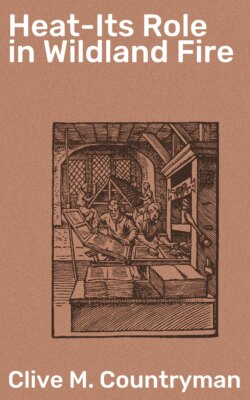Читать книгу Heat-Its Role in Wildland Fire - Clive M. Countryman - Страница 2
На сайте Литреса книга снята с продажи.
Table of Contents
ОглавлениеThe Nature of Heat
The science of heat is relatively new
Heat is energy
The joule is the standard unit of heat
Molecular structure affects temperature change
Heat capacity varies with density and specific heat
Much energy is involved in changes of state
Heat transfer is needed for a fire to burn and spread
Summary
Heat Conduction
Conduction is the transfer of heat by molecular activity
Heat conduction and fluid flow are alike
Temperature gradient affects conduction rate
Quantity of heat conducted varies with area
Fuel density affects thermal conductivity
Summary
Heat conduction and wildland fire
Heat conduction and combustion
Wildland fuels do not burn directly
Burning wood has four zones
The combustion process
Ignition depends on temperature and heat quantity
Ignition and combustion take longer in dense fuels
Moisture affects pyrolysis and ignition
Char slows pyrolysis
Heat Conduction and Fire Control
Small fuels are most important
To stop the fire, stop pyrolysis
Summary
Radiation
Radiation is energy in the form of electromagnetic waves
Radiation varies in wavelength
Radiation intensity and wavelength change with temperature
Radiation intensity changes with distance and angle
Substances differ in ability to emit and absorb radiation
Not all thermal radiation is absorbed
Some radiation is reflected
Substances tend to attain a common temperature
Summary
Radiation and wildland fire
Radiation and Weather
Heat reaches the earth through radiation
Surface and air temperatures follow radiation intensity
Variation in radiative heating controls weather
Radiation and Fuels
Radiation helps create fuels
Radiation intensity affects fuel moisture
Radiation and fire behavior
Fire is a high-temperature heat source
Radiation influences fire spread
Radiation creates problems in fire behavior and fire control
Some radiation problems can be alleviated
RADIATION AND FIREFIGHTING SAFETY
The body's ability to withstand heat is limited
Proper clothing will reduce heating by radiation
Survival in wildland fires is possible
The main flame wave is the greatest hazard
Motor vehicles can provide shelter
Buildings can sometimes be used
Escape from the fire if possible
Summary
